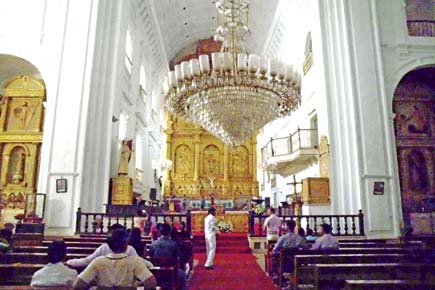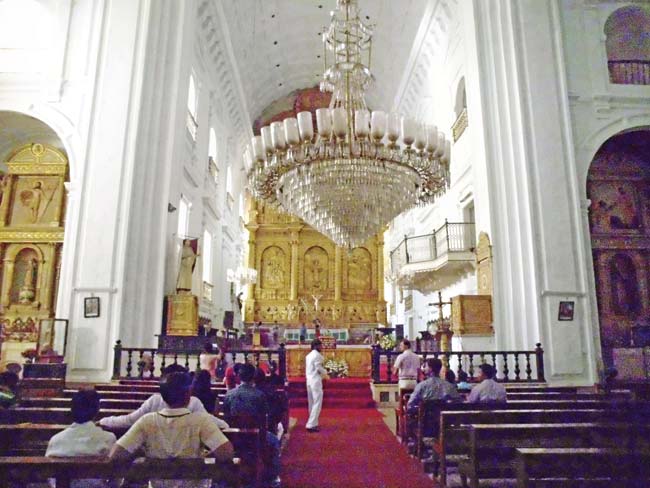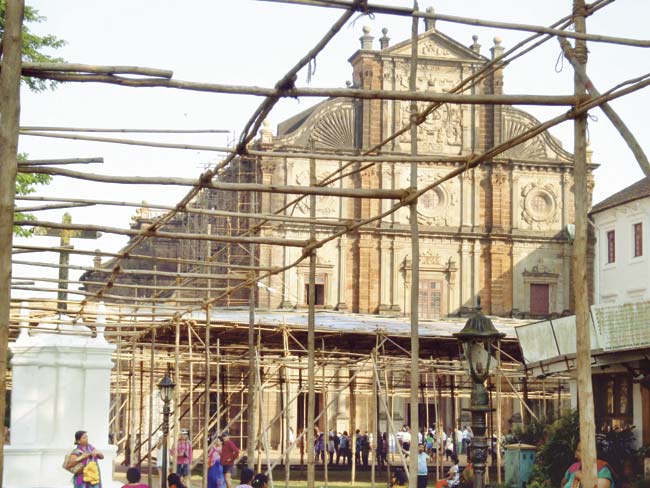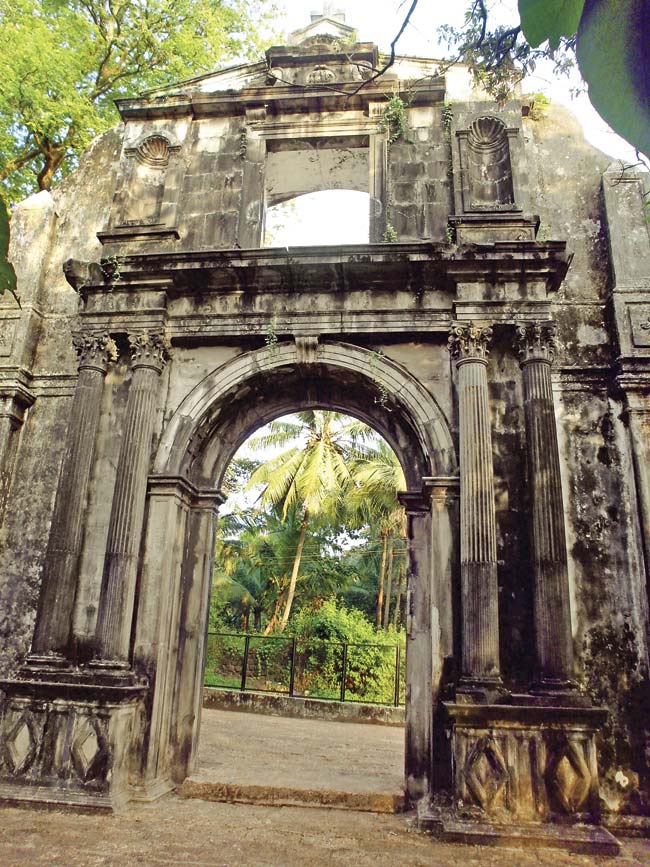All roads lead to Old Goa, as the seaside state braces for thousands coming in for the Exposition beginning November 22

The coming ‘Exposition of St Francis Xavier’ in Goa is going to probably be the biggest congregation of Catholics and Christians in the subcontinent. It begins on November 22 and ends on January 4 2015, and is expected to draw millions of pilgrims, tourists and the simply curious.
ADVERTISEMENT

Devotees pay homage to St Francis Xavier inside the Basilica of Bom Jesus where his body is kept
The Exposition centres around the public display and veneration of the ‘miraculous’ body of St Francis Xavier (SFX), a co-founder along with Ignatius of Loyola of the Society of Jesus (Jesuits) back in the 16th century. Born to a noble family in Spain in 1502, Francis Xavier was appointed an ‘apostolic messenger’ to the East present-day Asia by the then Pope.

Basilica of Bom Jesus gearing up for the Exposition
He also preached all along the Konkan coast, including Bassein and Vasai. After dying in Sancian, an island off Canton in China, his ‘miraculously preserved’ body was brought to Goa in March 1553 as his last wish was to be buried there.
Shift
It is the 17th Exposition so far, the first having been held in February 1782, though there had been ‘impromptu’ expositions of his body over the years by curious governors and bishops who wanted to see for themselves whether the body was indeed miraculously preserved. In recent decades, it has been held once in 10 years.

The derelict St Paul’s College gate, where St Francis Xavier was the rector for four years
Normally, the body rests in a silver casket in a marble mausoleum in the Basilica of Bom Jesus in Old Goa. During the Exposition, it is ceremonially shifted to neighbouring Se Cathedral, the largest church in Goa and India, which then witnesses unending queues of devotees who line up to kiss the casket and seek blessings.

Our Lady of the Rosary Church arch where St Francis Xavier preached frequently, while he was in Goa
The theme for this Exposition this year is ‘Faith creates communion, strengthens family, commissions to renew society’. In a message, Goa Archbishop Filipe Neri Ferrão says, “May the intercession of St Francis Xavier protect us from all danger and, turn us into more enthusiastic followers of Jesus and instruments of His Joy, Peace and Love.
I sincerely pray that this Solemn Exposition of the Relics of our Saint, and the massive spiritual preparation the Church in Goa is engaged in, may be an occasion for us to renew our faith-commitment and to live it out amidst the manifold challenges of our times. May it also bring the priceless gift of Jesus to many people who are sincerely searching for the real meaning and purpose of their lives.”
Global
Pilgrims are expected from all over the world, including Spain and Portugal from where a 35-year-old SFX had set sail on April 7, 1541 responding to the call of Pope Pius XI to go “to the farthest Indies” to spread the good news. On board the ship, ‘Santiago’ was also the next Governor-designate of Goa, Afonso de Souza.
The trip was financed by the Portuguese King Dom Joao III. He reached Goa, the Portuguese empire in Asia, on May 6, 1542 after sailing via the Cape of Good Hope. December 3 is now celebrated as the feast day of St Francis Xavier everywhere, but especially in Goa at the Basilica of Bom Jesus where his body rests. The Basilica is visited by thousands of pilgrims and tourists every day to view the body of the ‘Apostle of the East’.
Fascinated
Like many modern-day visitors, SFX was apparently enamoured of the city of Goa (then comprising present-day Old Goa and surrounding areas), describing it as Cosa par aver (something to behold). The Portuguese had conquered Goa, 32 years before SFX landed there. In those years many Goans had been converted to Catholicism, and SFX is recorded to have been very happy to see “A completely Christian city”.
An important figure in the propagation of the Catholic faith in Asia, he is not without controversy having converted thousands to Christianity, and for siding with the colonial powers. He is said to have written to the royal authorities in Portugal to extend the Inquisition to Goa. However, the Inquisition in Goa started 10 years after he died, and he is in no way connected with the alleged atrocities committed during the Inquisition.
Relevance
Fr Savio Barretto, rector of the Basilica of Bom Jesus for 11 years, says, “St Francis Xavier was concerned with the purity of the Catholic faith. At that time people who were newly converted used to mix up things because of old superstitions. He wanted them to be more observant of the Catholic religious practices.”
Francis Xavier was made a saint 60 years after his death when the miracle of his body was established. After he died in Sancian in December 1552, he was buried there with the coffin packed with limestone so that his body would decay faster in the expectation that the remnant bones could then be more easily transferred back to Goa.
But after they dug up the remains, they were astonished to find the body still quite fresh. It was then brought to Malacca and from there back to Goa in March, 1554. In 1614, the right arm was cut and sent to the Pope in Rome who wanted confirmation that the body was ‘incorruptible’. He was declared a saint in 1622 by Pope Gregory XV. Pope Pius XI later proclaimed him the ‘Patron of Catholic Missions’.
Heritage
Although Francis Xavier was constantly travelling, he was also the rector of the College of the Holy Faith for four years (it was later renamed St Paul’s College and was the first deemed university in Asia).
Except for the gate, nothing remains of the college in Old Goa where most of the surviving churches and monuments are now part of a World Heritage Site, with his tomb the most precious part.
The tomb itself is an exquisite piece of art. While in the first couple of centuries, his body would be open for veneration during the first few expositions, it is now in a sealed glass coffin inside a silver casket to prevent it from decaying.
Message
According to Fr Alfredo Judas Vaz, convenor, St Francis Xavier 2014 Exposition Committee, SFX was a great communicator, and his sacred remains are a message of God’s presence and power among men, with many still experience the divine presence and power, as they pray before him, he says.
Just two days from now, the silver casket will be taken in a ceremonial procession across the boulevard to Se Cathedral, where it will be kept for veneration till January 4. There will be mass from pre-dawn hours to well into the evening, in a number of languages.
The Exposition also coincides with the peak tourist season in Goa. The Goa government has broadened the road leading there. Truly, all roads lead to Old Goa, including the new, recently broadened one.
 Subscribe today by clicking the link and stay updated with the latest news!" Click here!
Subscribe today by clicking the link and stay updated with the latest news!" Click here!






